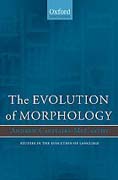
This book considers the evolution of the grammatical structure of words in the more general contexts of human evolution and the origins of language. The consensus in many fields is that language is well designed for its purpose, and became so either through natural selection or by virtue of non-biological constraints on how language must be structured. Andrew Carstairs-McCarthy argues that in certain crucial respects language is not optimally designed. This can be seen, he suggests, in the existence of not one but two kinds of grammatical organization - syntax and morphology - and in the morphological and morpho-phonological complexity which leads to numerous departures from the one-form-one-meaning principle. Having discussed the issue of good and bad design in a wider biological context, the author shows that conventional explanations for thenature of morphology do not work. Its poor design features arose, he argues, from two characteristics present when the ancestors of modern humans had a vocabulary but no grammar. One of these was a synonymy-avoidance expectation, while the other was an articulatory and phonological apparatus that encouraged the development of new synonyms. Morphology developed in response to these conflicting pressures. INDICE: 1: Design in Language and Design in Biology 2: Why There is Morphology: Traditional Accounts 3: A Cognitive-Articulatory Dilemma 4: Modes of Synonymy Avoidance 5: The Ancestors of Affixes 6: The Ancestors of Stem Alternants 7: Derivation, Compounding, and Lexical Storage 8: Morphological homonymy and Morphological Meanings 9: Conclusions.
- ISBN: 978-0-19-929978-2
- Editorial: Oxford University
- Encuadernacion: Cartoné
- Páginas: 253
- Fecha Publicación: 01/01/2010
- Nº Volúmenes: 1
- Idioma: Inglés
